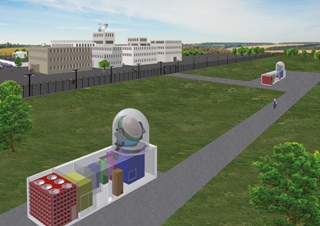Jul 2 2015
Space debris poses a growing threat to satellites and other spacecraft, which could be damaged in the event of a collision. A new German space surveillance system, schedu- led to go into operation in 2018, will help to prevent such incidents. The tracking radar is being developed by Fraunhofer researchers on behalf of DLR Space Administration.
 Both the transmitting and receiving antennas are fully retractable. © Fraunhofer FHR
Both the transmitting and receiving antennas are fully retractable. © Fraunhofer FHR
Traffic congestion is also an issue in space where, in addition to the dense network of satellites, orbiting space debris is increasingly transforming the paths on which they travel into a junkyard populated with burnt-out rocket stages and fragments of disintegrated spacecraft. Scientists estimate that there are now some 20,000 particles of space junk measuring more than ten centimeters in diameter hurtling around Earth at an average velocity of 25,000 kilometers per hour, not counting the 700,000 or so particles with a diameter of between one and ten centimeters. Although small, these items of space debris are traveling so fast that they could easily damage or destroy an operational satellite. The situation is exacerbated by the fact that space debris has a tendency to multiply exponentially through a kind of snowball effect. Whenever two particles collide, they break up into a greater number of smaller particles. Unless preventive measures are taken, the rapid multiplication of space debris could soon put an end to spaceflight as we know it.
There is urgent need for action. The Space Administration division of the German Aerospace Center (DLR) has been tasked by the German government with designing the German space program. In turn, DLR Space Administration has awarded a contract to the Fraunhofer Institute for High Frequency Physics and Radar Techniques FHR in Wachtberg to develop and build a radar system for monitoring and tracking objects in low-Earth orbit. This is the region of space in which the risk of collisions is at its greatest – especially at an altitude of 800 kilometers above Earth. The German Federal Ministry for Economic Affairs and Energy (BMWi) has granted a total of 25 million euros to finance the GESTRA (German Experimental Space Surveillance and Tracking Radar) project over a four-year period.
“Whether we realize it or not, we all depend on space-based navigation, communication and Earth observation services – they are part of our social, political and industrial infrastructure. In order to protect these satellites from danger, we need to know what’s happening up there in space,” says Dr. Andreas Brenner, department head and deputy director of Fraunhofer FHR. With GESTRA, it will be possible to gather data on the trajectory of satellites and space debris orbiting Earth at altitudes of between 300 and 3000 kilometers. One of the chief purposes of the experimental radar is to provide advanced warning of possible collisions, and also to trigger an alarm when objects leave their orbit and reenter Earth’s atmosphere.
Electronically controlled, rapidly movable antenna
The FHR researchers are no newcomers when it comes to building radar systems. Their TIRA (Tracking and Imaging Radar) system is already being used to track objects in space. “TIRA collects high-definition images of individual objects using a mechanically controlled, movable antenna. The novel feature of the new GESTRA system is that its antenna is electronically controlled, and can therefore be reoriented even faster because it has no heavy moving parts. Unlike TIRA, it is capable of observing a very large number of objects simultaneously while still supplying data of high accuracy and sensitivity,” says Brenner.
A team of twenty researchers is responsible for building both the transmission and reception components of the transceiver system. Each of these sensing components consists of a phased-array antenna operating at a frequency of 1.3 GHz and made up of numerous individual antenna elements. This array antenna is equipped with high-performance processors that enable it to capture radar signals emitted by satellites and space debris in several cardinal directions simultaneously, in a fraction of a second. It can look in many directions at once and cover a very large area of the sky. “In tracking mode, we can follow the path of selected, individual objects. The computer-assisted, digital beamforming function allows the main beam to be set to a narrow width, enabling it to be focused on a single moving object. This could be compared with the cone of light produced by a pocket flashlight. Alternatively, the main beam can be extended in width to observe a broader section of the sky, allowing several pieces of debris to be tracked,” Brenner explains.
Both the transmission and the reception units are fully retractable. This is an advantage because it allows the container in which the radar is housed, measuring 4 x 4 x 16 meters, to be transported from place to place. GESTRA will be operated by remote control from the German Space Situational Awareness Centre in Uedem, which is run jointly by the DLR and the German air force, while the radar itself will be installed at a different location. The space monitoring system is scheduled to start delivering data in 2018. The data from GESTRA will be made available to research institutions in Germany and form the basis for the development of future space surveillance systems.